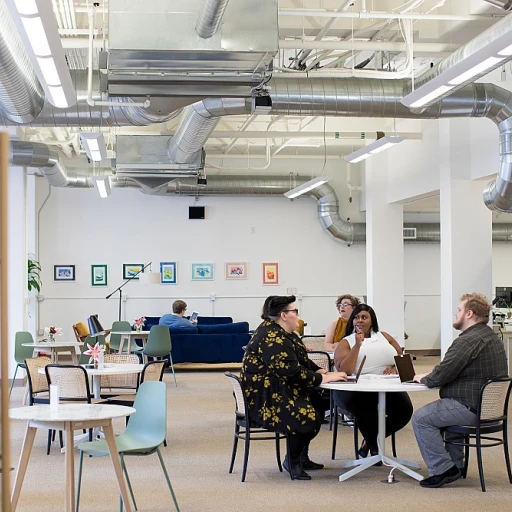Understanding Employee Experience
The Heartbeat of a Thriving Workplace
In recent years, the concept of employee experience has emerged as a crucial factor in shaping workplace dynamics and enhancing productivity. But what exactly does employee experience entail? At its core, employee experience encompasses every interaction and touchpoint between an employee and their organization, from recruitment to exit. It's a holistic approach that considers the emotional, physical, and technological aspects of the workplace. A positive employee experience can lead to increased satisfaction, engagement, and ultimately, productivity.
When employees feel valued, supported, and empowered, they are more likely to bring their best selves to work. This doesn't just happen by chance, though. It requires intentional efforts from organizations to create an environment that fosters growth and well-being. From flexible work arrangements to a strong sense of community, several elements contribute to crafting a meaningful employee experience.
Companies are increasingly recognizing the importance of employee experience and are turning to innovative strategies to create a supportive environment. By prioritizing a seamless and positive experience, businesses can see significant returns in terms of engagement levels and performance outcomes. To learn more about the current trends and strategies organizations are leveraging, explore the
latest employee experience trends. This journey into employee experience not only enhances overall morale but also drives sustained productivity and success in today’s competitive landscape.
The Role of Company Culture
The Influence of Corporate Environment
A positive employee experience is deeply intertwined with the corporate environment in which individuals operate. Think of company culture as the DNA of your organization. It's what shapes interactions, guides decision-making, and influences overall productivity. When employees feel connected to the culture of their workplace, they're more likely to feel engaged, valued, and motivated to contribute to the company's success.
Let's consider the aspects that form a robust company culture. It’s a combination of shared values, practices, and behaviors that create a harmonious atmosphere. Employees who resonate with these aspects often exhibit higher job satisfaction and are more likely to stay at their current job, reducing turnover rates. This correlation can be seen in the way successful organizations invest time and resources in cultivating a culture that resonates with their workforce.
Transparency and communication are vital components of a thriving company culture. Providing clear and open lines of communication can prevent misinformation and foster a sense of belonging among employees. When team members feel they can express their thoughts without fear of repercussion, it enhances trust and collaboration across all levels of the organization.
Moreover, promoting diversity and inclusion within the workplace strengthens company culture by bringing varied perspectives and innovative ideas to the table. A culture that values and respects individuality can improve employee satisfaction and engagement, resulting in heightened productivity. Encouraging employees to bring their authentic selves to work can lead to more dynamic problem-solving and creativity.
For businesses looking to harness the positive effects of a constructive company culture, understanding the latest
employee experience trends is crucial. By staying informed and adaptive, companies can align their culture with the evolving expectations of the workforce, ensuring employees feel valued and inspired every step of the way.
Onboarding and Employee Lifecycle
The Significance of a Seamless Onboarding Process
A well-crafted onboarding process lays the foundation for a positive employee experience. It is during this crucial time that new hires form their initial perceptions of the company and its culture. For many, these first impressions can be lasting and significantly impact their engagement and productivity levels moving forward.
To create an effective onboarding experience, it's essential for organizations to focus on personalization and clarity. Employees appreciate a tailored onboarding process that caters to their individual roles and responsibilities. This includes providing them with the necessary tools and resources, as well as having well-defined expectations and goals.
Moreover, engaging new employees during onboarding through mentorship programs or team-building activities can foster a sense of belonging and community. When employees feel connected to their peers and the company, they are more likely to remain motivated and committed to their job.
Nurturing Growth Throughout the Employee Lifecycle
The employee experience doesn't end with onboarding; it extends throughout the entire employee lifecycle. As employees progress in their careers, organizations should focus on continuously nurturing their growth and development. This includes offering opportunities for advancement, professional development programs, and the chance to take on new and challenging projects.
One critical aspect of the employee lifecycle is feedback. Regular feedback sessions can empower employees and allow them to see their contributions to the company. By providing constructive feedback, managers can help employees identify areas for improvement while also acknowledging their strengths.
Furthermore, an effective employee experience strategy should include initiatives for employee recognition and rewards. Acknowledging achievements and celebrating milestones not only boosts morale but also reinforces a culture of appreciation and support.
For businesses looking to enhance their employee experience strategies, implementing
tools to build an outstanding employee experience can be a game-changer. These tools provide insights and solutions that cater to evolving employee needs and expectations. Understanding and adapting to these needs is vital in ensuring employees remain engaged and productive over time.
Balancing Work and Life
Finding Harmony in Work-Life Integration
Achieving a harmonious balance between personal and professional life is a pivotal component in enhancing the overall employee experience. With the lines between work and personal time becoming increasingly blurred, employers must implement strategies that support employees in managing their work-life balance effectively.
Flexible working arrangements, like remote work, flexible hours, and compressed workweeks, play a significant role in promoting this balance. By allowing employees to tailor their work schedules, companies create an environment where individuals can better attend to personal responsibilities without compromising professional commitments. This flexibility not only boosts job satisfaction but also enhances productivity, as employees feel more in control and less stressed.
In addition to flexible schedules, offering resources for mental health and well-being is crucial. Providing access to counseling services, stress management workshops, and well-being programs ensures that employees have the necessary support to manage stress and maintain a healthy mind, which is essential for sustaining productivity and engagement.
Company culture also intersects with work-life balance. As mentioned previously, fostering a culture that values open communication and empathy allows employees to feel comfortable discussing their work-life needs. Encouraging managers to lead by example and prioritize their work-life balance can further reinforce this cultural norm, empowering all employees to seek the balance they deserve.
Ultimately, when organizations invest in and support the work-life balance of their employees, they are investing in a more committed, fulfilled, and productive workforce. Such initiatives are key to cultivating a positive employee experience, which can significantly impact the overall productivity of the company.
Enhancing Efficiency with the Right Tools
As companies strive to boost employee experience, the adoption of dedicated platforms and tools becomes a vital element of the strategy. These technological advancements play a pivotal role in streamlining processes, facilitating communication, and empowering employees, ultimately driving productivity to new heights.
Employee experience platforms serve as centralized hubs where employees can access information, collaborate with colleagues, and receive feedback in real-time. These platforms are tailored to simplify everyday tasks, reducing friction and allowing employees to focus on their core responsibilities. Deploying such tools not only improves workforce efficiency but also elevates satisfaction by promoting a user-friendly work environment.
In addition to comprehensive platforms, various tools cater to specific aspects of the employee experience. For instance, communication tools enhance collaboration, project management software organizes tasks and deadlines, and well-being apps support personal and professional balance. These resources align with the principles of balancing work and life, offering employees the versatility to manage their time and workload effectively.
Moreover, understanding the ongoing impact of these platforms and tools is crucial for assessing their success within an organization. By incorporating meaningful metrics and feedback mechanisms, companies can measure how these technologies influence employee engagement and performance. This approach is key to ensuring that the tools remain relevant and evolve according to the changing needs of the workforce.
In conclusion, while a strong company culture lays the groundwork for a positive employee experience, leveraging the right technology significantly amplifies productivity. Organizations that invest in robust platforms and tailored tools are better positioned to foster an engaged and efficient workforce.
Tracking Success Through Engagement Metrics
A thriving employee experience directly contributes to increased productivity, but how can companies effectively measure this success? Analyzing key performance indicators related to employee engagement and performance is essential for recognizing areas of strength and identifying opportunities for improvement.
Employee engagement surveys are one of the most effective tools for gauging success. They provide insights into how employees feel about their roles, work environment, and the organization as a whole. These surveys can shed light on numerous factors discussed earlier, such as how well the company culture resonates with its workforce or if the onboarding process is aligning new hires with company values.
Another crucial component is tracking employee retention rates. A positive employee experience often results in lower turnover rates—a key indicator of employee satisfaction and productivity. By understanding the employee lifecycle in detail, organizations can pinpoint which stages might be contributing to higher attrition and what can be enhanced to foster loyalty.
Performance metrics should also be part of the evaluation process. These metrics reveal how effectively employees are meeting their goals and how their productivity levels may be influenced by various elements of their work experience. Balanced work-life dynamics often translate into higher performance as employees feel supported and motivated to excel in their roles.
By implementing a system that reviews these different metrics regularly, businesses can remain attuned to their employees' needs and make informed decisions on where to focus their engagement strategies. These metrics, combined with intuitive employee experience platforms, can transform data into actionable insights that drive continuous improvement in both employee satisfaction and business outcomes.
In conclusion, measuring success through employee engagement and performance metrics is integral to understanding the full impact of your strategies. This evidence-based approach will serve as the foundation for cultivating a work environment where employees feel valued, leading to sustained productivity and organizational success.








